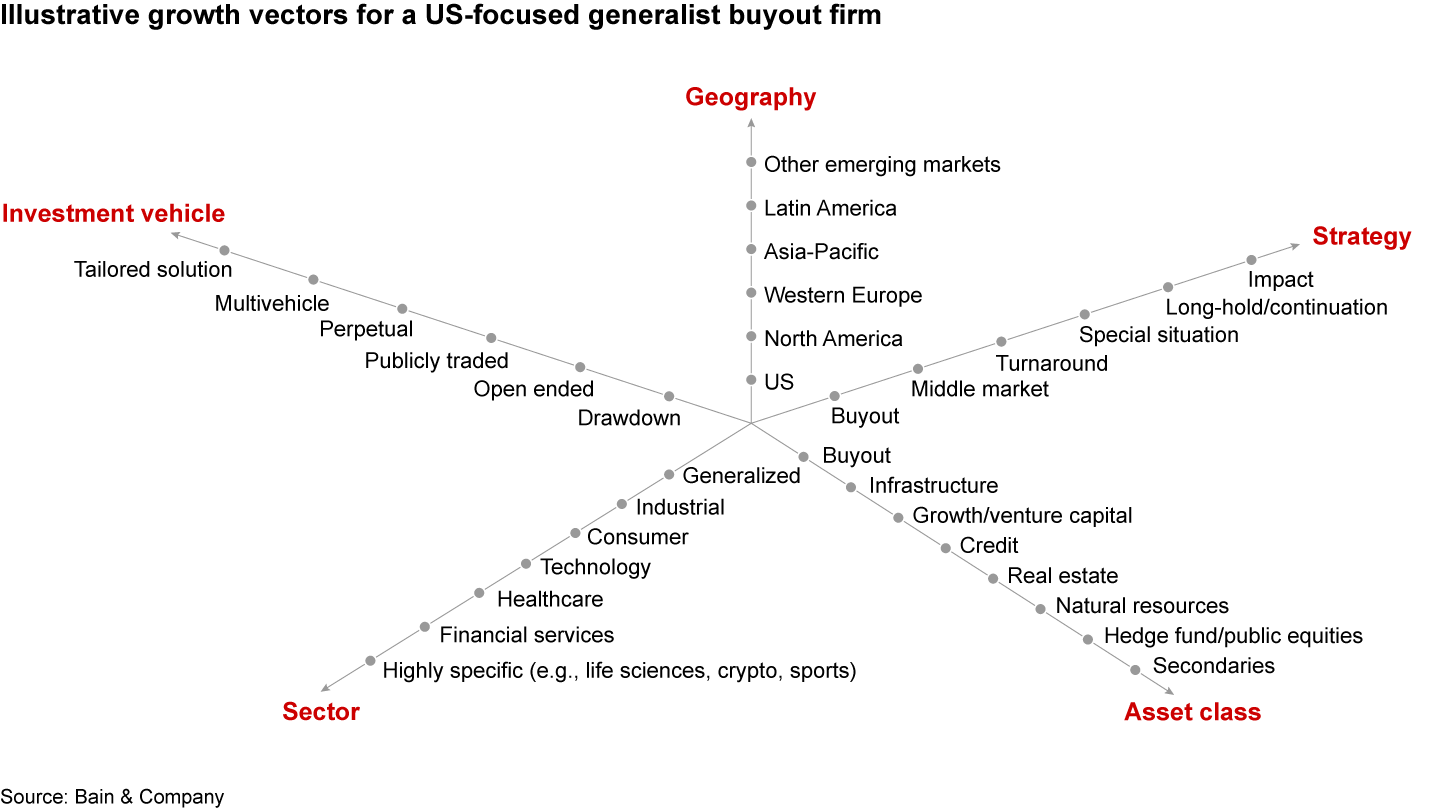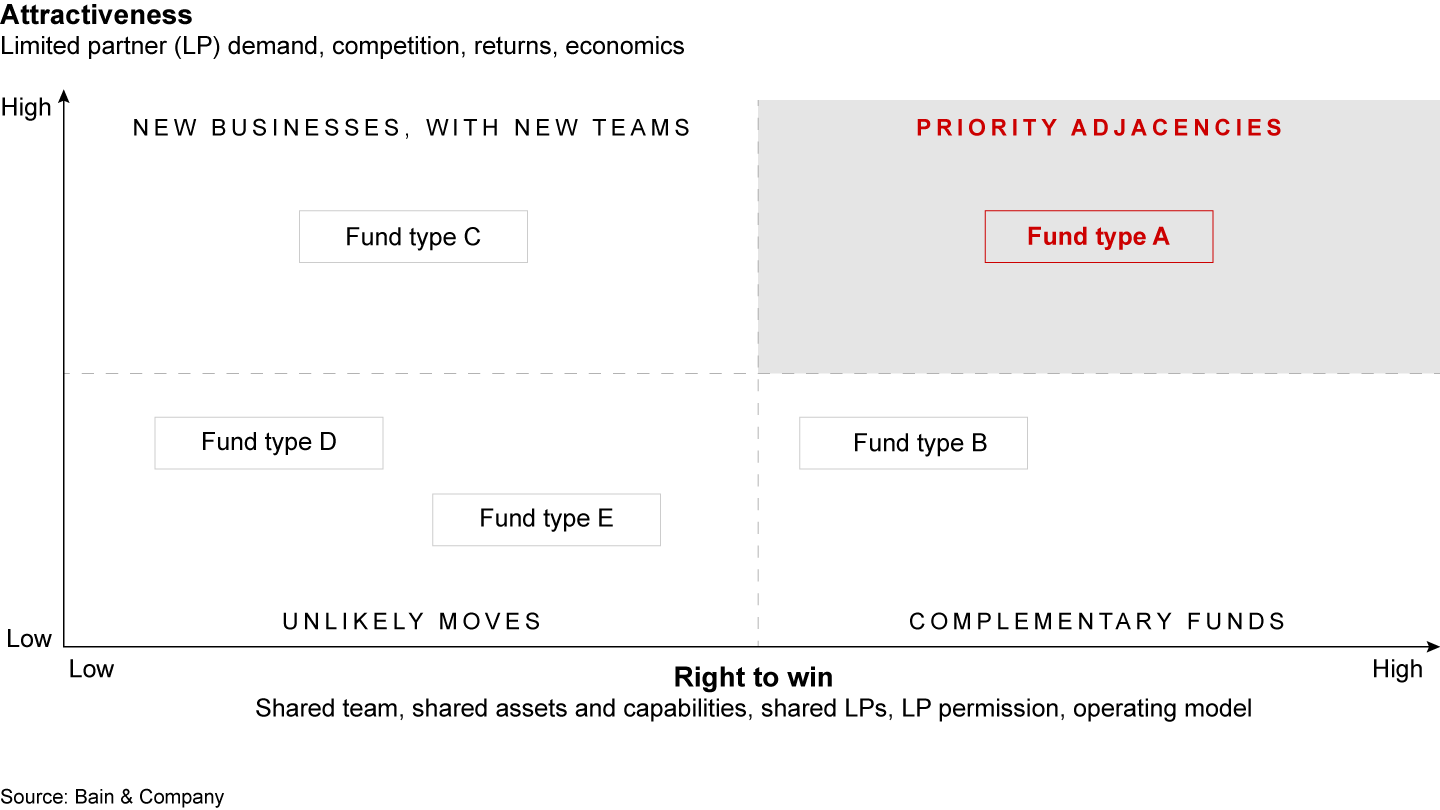Brief
 }
}
The vast majority of private equity firms have a growth imperative.
Steady expansion of assets under management (AUM) is the best way for any firm to generate a predictable stream of fees. For single-focus firms, diversification into strategies that are less cyclical, or countercyclical, can increase stability. Striking out in a new direction may be the key to expanding share of wallet with limited partners (LPs) looking for exposure elsewhere on the risk/reward spectrum. For maturing firms, expansion is often about talent; it can be critical for retaining or attracting the best people.
The number and variety of growth strategies have exploded in recent years as firms look for alternatives beyond their core (see Figure 1). One of the most popular, however, is also among the riskiest: asset class expansion. In practice, too many of these asset class adjacency moves end up as small side businesses that aren’t particularly strategic or profitable. In the worst cases, firms cut their losses and exit the business altogether. A Bain & Company analysis shows that over 60% of the firms that pursue asset class expansion will retrench from at least one of those pursuits over time.

What goes wrong?
While many firms assume that success in the buyout world will translate smoothly to, say, credit investing or infrastructure, that’s often not the case. Despite the common umbrella of “private capital,” synergies across most asset classes are relatively minor. Different asset classes often require sharply different capabilities across the investment value chain—from sourcing and underwriting to deal structuring, value creation, and exit. Each class has a unique ecosystem requiring a distinct set of relationships. And though there may be some overlap among sources of capital across funds, the decision makers responsible for each class tend not to be the same.
The basis of competition also varies widely across asset classes. While a small to midsize buyout firm can thrive in a lucrative niche, asset classes like liquid credit or core real estate are driven by massive scale. Expanding into these areas demands a clear-eyed assessment of what sort of investment it would take to establish critical mass and, importantly, whether the firm is prepared to make that kind of commitment. Asset classes like growth equity and venture capital may share more with buyout in terms of capabilities and business model, but, increasingly, they require deep, specialized expertise in technology and the ability to make deals at a much faster pace. Success in underwriting infrastructure risk, meanwhile, may turn on how well the firm understands specific government regulations or local political realities.
If the firm lacks the requisite capabilities, networks, or experience to break into a new business, it will have to add new talent. That raises the buy or build dilemma and sparks tricky questions at the operating level about how to set up the new team for success. Private equity is a people business, and integrating new talent always presents risks that have to be managed carefully. Transforming what amounts to a single-line business into a multiline organization means allocating resources and economics in ways that may be unfamiliar or disruptive.
A strong buyout fund, for instance, generates strong economics for the firm. By nature, that’s less true of other asset classes like infrastructure or natural resources. When adding one to the other, how do you share firmwide economics in a way that feels good to everybody? And how do you allocate resources: Does the fund-raising organization cover both businesses, or do you need to build a new one?
While the tendency is to assume these details are easily solvable, they aren’t. In fact, they can have major consequences for the firm; the complexity of integration can easily overwhelm the organization.
None of this is to say that asset class expansion is a bad idea. But the firms getting it right work hard to confirm that it is a good idea for their firm and investors. That involves a thorough two-part analysis: Is the asset class really as attractive as it might seem? And if it is, do we actually have a right to win based on our talent, resources, and appetite for taking on a new business (see Figure 2)?

These questions lead to several practical considerations that can help frame the issues.
Attractiveness
- LP demand: Is this an area that has attracted the interest of a large number of investors and significant capital?
- Competition: Who is competing in the space now? How good are they, and is there room for new entrants?
- Returns: How high are typical returns for this asset class? Are returns similar to or better than what we offer our investors today?
- Economics: What is the typical fee structure for this asset class? What is a realistic size for Fund I, and what scale is required to compete? Can we achieve that size in a reasonable time frame with a workable investment?
Right to win
- Shared team: Can our existing team (investment professionals and others) succeed within this new adjacency? If not, how much new talent will we need to add, and are attractive candidates or acquisition targets available? What will it take to integrate the new team with our unique culture?
- Shared assets and capabilities: To what extent will our differentiated assets and capabilities help us win in this adjacency (sourcing networks, operational expertise, sector knowledge, etc.)? How much capability building (or buying) is required?
- Shared LPs: Will our existing LPs invest with us in this strategy, and are they enthusiastic about placing capital there?
- LP permission: How will LPs perceive our expansion? Will they see it as complementary or as a distraction? Could this perception harm future fund-raising?
- Operating model: Will this move take advantage of our existing infrastructure and operations, or will it involve some level of transformation? Is it culturally aligned with the current team and style of investing? Will the economics work to everyone’s advantage?
The most important message here is that a growth imperative isn’t enough. It has to be matched with a differentiation imperative that gets just as much attention from leadership. More than anything else, LPs want to know that a general partner can reliably outperform the average in whatever asset class its funds invest in. Growth in AUM comes from demonstrating a clear, competitive advantage and the ability to deliver results.
This has never been more true than in today’s fund-raising environment, where new capital is suddenly harder to come by. Growth for growth’s sake won’t play. The imperative is to demonstrate how your firm is going to win.

